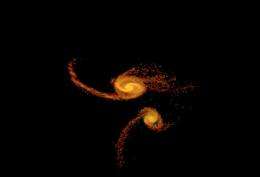November 26, 2010 report
Collisions of two galaxies may have formed Andromeda (w/ Video)

(PhysOrg.com) -- New computer simulations suggest the nearest galactic neighbors to our own Milky Way, the Magellanic Clouds and the Andromeda Galaxy, may have been shaped by the massive collision of two galaxies billions of years ago.
The Milky Way lies in a region known to astronomers as the “Local Group,” which consists of almost 40 galaxies, including the two biggest: Andromeda Galaxy and the Milky Way. Both are massive spiral galaxies.
Astronomers have thought the Andromeda Galaxy (Messier 31), which is around 2.5 million light-years away from Earth, was formed by a merging of two smaller galaxies or a combination of many smaller mergers, but the ideas had never been tested or dated before. So a team of researchers in France and China decided to model how the galaxy might have evolved.
The simulations were carried out on high performance computers and used around eight million particles to simulate gas, dark matter, and stars. They modeled the gravitational and fluid interactions between the elements and found they could simulate the formation of Andromeda if two galaxies merged: one slightly larger than the Milky Way and the other around one third the size.
The astronomers, led by Dr. François Hammer of the Observatoire de Paris, were able to reproduce most of the properties of Andromeda, such as its huge central bulge, large, thin disk, massive ring of dust and gas, and huge stream of old stars. The computer simulation showed the two galaxies began to merge in a violent collision starting around 8.75 billion years ago with fusion occurring around 3.5 billion years later.
The collision must have been extremely violent to produce the massive angular momentum required to form the Andromeda Galaxy. It would have been the most dramatic and important event in the history of the Local Group.
The computer simulation also predicted the collision would have led to the formation of massive streams (called tidal tails) of long, thin areas of stars and interstellar gas with a total mass around a third that of the Milky Way.
The researchers think one such tail may have formed the Large and Small Magellanic Clouds, which are small, irregular, satellite galaxies apparently passing the Milky Way or orbiting at a distance of about 180,000 light years. If they did originate in the collision, they would have been ejected towards the Milky Way at around a million kilometers per hour (620,000 mph).
Hammer and the team took the known peculiar velocities of the Magellanic Clouds and traced their positions back several billions of years, and found a number of solutions that had their origin in the Andromeda Galaxy.
The results support the hypothesis that spiral galaxies are mostly formed by collisions between galaxies, and the hypothesis that dwarf galaxies often originate from tidal tails formed by mergers. The findings may also affect the estimations of the amount of dark matter in galaxies.
The results of the research, which also involved scientists from the National Astronomical Observatory of China (NAOC), are published in Astrophysical Journal Letters and The Astrophysical Journal.
More information: -- F. Hammer et al (2010) Does M31 results from an ancient major merger ? ApJ 725 542. doi:10.1088/0004-637X/725/1/542
-- Y. B. Yang et al (2010) Could the Magellanic Clouds be tidal dwarves expelled from a past-merger event occurring in Andromeda? Astrophysical Journal Letters fr.arxiv.org/PS_cache/arxiv/pd … 1010/1010.2748v2.pdf
-- French press release: www.grandpublic.obspm.fr/Il-y- … x-milliards-d-annees
© 2010 PhysOrg.com





















